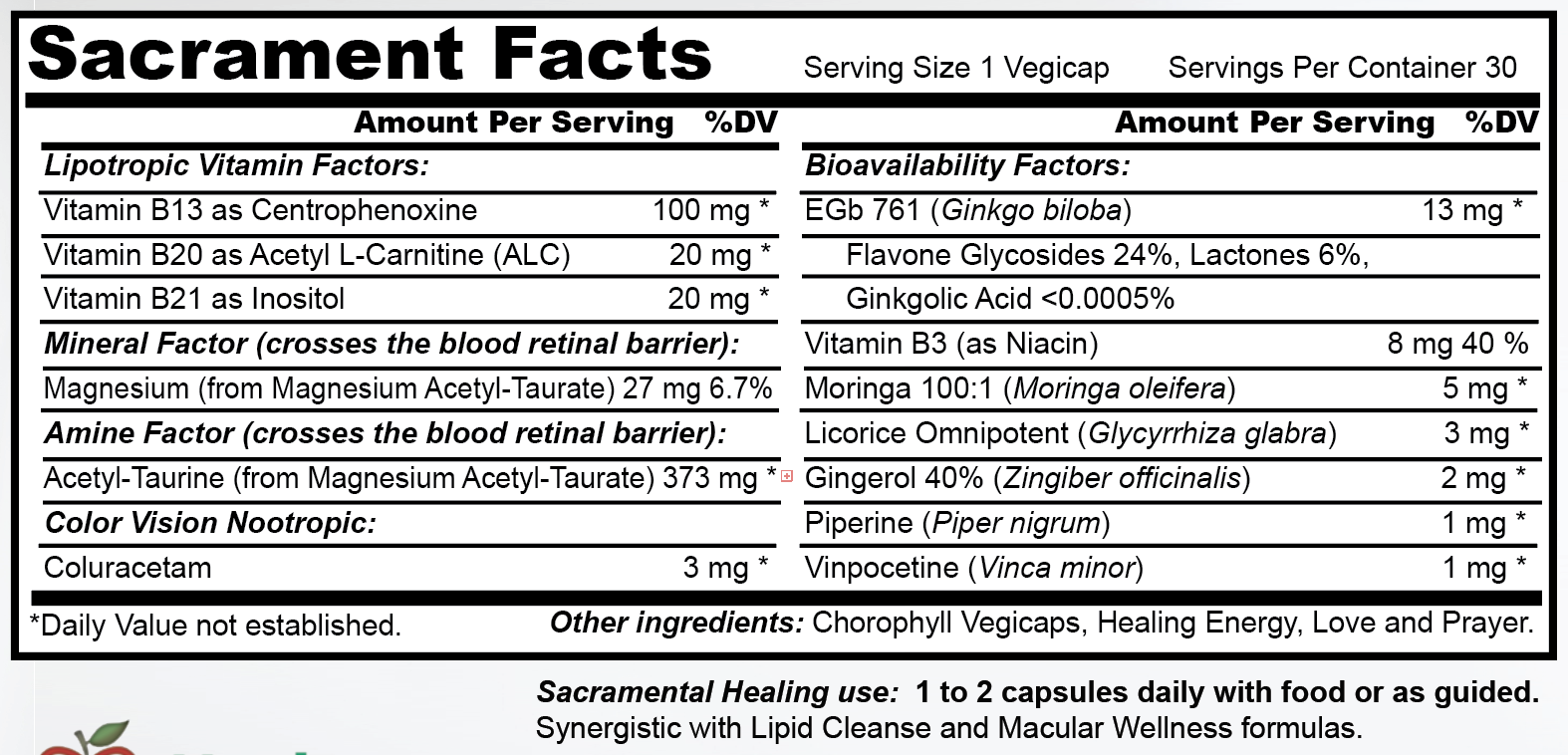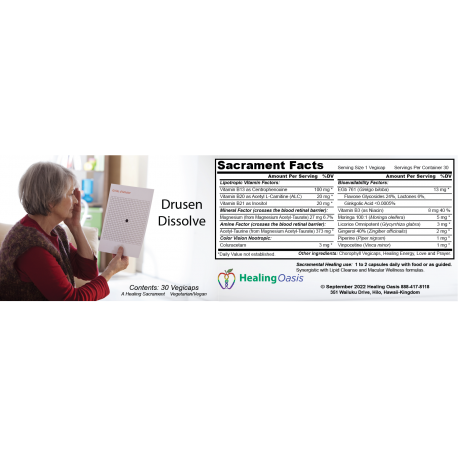Drusen Dissolve With Meals
Drusen Dissolve supports the restoration of healthy retinal structure and function.
Soft drusen produce visual distortion on the Amsler Grid test for monitoring Macular Degeneration.
Drusen are accumulations of waste products of retinal metabolism.
Dissolving and reversal of drusen formation has been reported with long-term use of broad-spectrum macular health supplements high in Magnesium Taurate.
Magnesium Acetyl Taurate crosses the blood-brain and the blood-eye barriers, including the barrier between the blood and the retina.
Magnesium Acetyl Taurate is a specialized nutrient that is not widely available, costing about 30 times as much as Magnesium Taurate.
However, results are the ultimate metric standard, making the investment in your health and vision cost-effective.
In practical terms, the most expensive solutions are often the cheap ones, such as commercial supplements which add Magnesium Stearate or Stearic Acid to produce large quantities on high-speed encapsulation machines.
As we describe on another of our websites, Stearates form a biofilm on the supplements and your intestinal mucosa, impairing the bioavailability and absorption of nutrients even from your diet.
Instead, we have developed small-scale, low-speed artisan apothecary systems so you can count on the highest purity, excipient-free, clinically powerful remedies.
Combined with our lifelong alchemical experience of formulating products and programs for individuals like you, our Functional Formulations™ are incomparable in the marketplace.
Our deeply researched remedies often included as many as two or three dozen synergistic ingredients, producing a more robust entourage effect than typical products based on a single study.
Beyond mere 'supplements' for the body, our sacramental remedies are designed to nourish and activate the causal healing processes of body, mind, and soul.
More details:
Each Chlorophyll vegicap of Drusen Dissolve supplies:
Lipotropic Vitamin Factors:
Vitamin B13 as Centrophenoxine 100 mg
Centrophenoxine enhances uptake and then breaks down into DMAE providing lipofuscin scavenging. If Centrophenoxine is not available, substitute DMAE.
(Note: Magnesium is nature's Calcium Channel Blocker - see below) "Purpose: To investigate the role of Ca2+ in lipofuscin formation in human retinal pigment epithelial (RPE) cells that phagocytize bovine photoreceptor outer segments (POSs). Methods: Cultured human RPE cells fed with 2 × 107 per l bovine POS were treated with flunarizine, an antagonist of Ca2+ channel, or/and centrophenoxine, a lipofuscin scavenger.... Conclusions: The Ca2+ inflow initiated lipofuscin accumulation in RPE cells fed with POS. Flunarizine and centrophenoxine can decrease Ca2+ overload and lipofuscin formation in RPE cells, accompanied by maintaining cellular vitality." Source: Calcium overload is associated with lipofuscin formation in human retinal pigment epithelial cells fed with photoreceptor outer segments
The main results were better performance in psychometric tests (Pék et al., 1989) and a significant increase of the average intracellular water content (2.2-2.5% by weight) in the verum-treated group. The rehydration of the intracellular mass due to CPH treatment is consistent with the OH(*.) free radical scavenger properties of CPH and the predictions of the membrane hypothesis of aging. Source: Effects of centrophenoxine on body composition and some biochemical parameters of demented elderly people as revealed in a double-blind clinical trial
Vitamin B20 as Acetyl L-Carnitine (ALC) 20 mg
The majority of ocular pathologies originate from a functional deterioration of intraocular tissues. This age-related deterioration often occurs as a result of changes within the eye. There is growing interest in the role of natural or synthetic compounds, such as carnitine, for blocking, or slowing, the progress of this deterioration. L-carnitine and its derivatives are involved in numerous physiological reactions, including sugar aerobic metabolism, oxidative phosphorylation, fatty acid oxidation and osmosis. While carnitine levels in human ocular tissue are unknown, animal studies indicate that carnitine is differentially distributed within the eye with the highest concentrations reported in the iris, ciliary body and the choroid-retina. In patients with age-related macular degeneration (AMD), acetyl-L-carnitine improved four parameters of visual function, including visual field mean defect, visual acuity, foveal sensitivity and ocular fundus alterations. L-carnitine has also demonstrated antioxidant properties in animal models of oxidative damage. This article reviews the potential use of L-carnitine and its derivatives in age-related ocular pathologies, such as AMD, cataract, glaucoma and dry eye syndrome. Source: The aging eye and the role of L-carnitine and its derivatives
A large body of evidence points to the positive effects of dietary supplementation of acetyl-L-carnitine (ALC). Its use has shown health benefits in neuroinflammation, which is a common denominator in a host of neurodegenerative diseases. ALC is the principal acetyl ester of L-Carnitine (LC), and it plays an essential role in intermediary metabolism, acting as a donor of acetyl groups and facilitating the transfer of fatty acids from cytosol to mitochondria during beta-oxidation. Dietary supplementation of ALC exerts neuroprotective, neurotrophic, antidepressive and analgesic effects in painful neuropathies. ALC also has antioxidant and anti-apoptotic activity. Moreover, ALC exhibits positive effects on mitochondrial metabolism, and shows promise in the treatment of aging and neurodegenerative pathologies by slowing the progression of mental deterioration. In addition, ALC plays neuromodulatory effects on both synaptic morphology and synaptic transmission. These effects are likely due to affects of ALC through modulation of gene expression on several targets in the central nervous system. Source: The neurobiology of acetyl-L-carnitine
Vitamin B21 as Inositol 20 mg
Inositols are sugar-like compounds that are widely distributed in nature and are a part of membrane molecules, participating as second messengers in several cell-signaling processes. Isolation and characterization of inositol phosphoglycans containing myo- or d-chiro-inositol have been milestones for understanding the physiological regulation of insulin signaling. Other functions of inositols have been derived from the existence of multiple stereoisomers, which may confer antioxidant properties. In the brain, fluctuation of inositols in extracellular and intracellular compartments regulates neuronal and glial activity. Myo-inositol imbalance is observed in psychiatric diseases and its use shows efficacy for treatment of depression, anxiety, and compulsive disorders. Epi- and scyllo-inositol isomers are capable of stabilizing non-toxic forms of β-amyloid proteins, which are characteristic of Alzheimer's disease and cognitive dementia in Down's syndrome, both associated with brain insulin resistance. However, uncertainties of the intrinsic mechanisms of inositols regarding their biology are still unsolved. This work presents a critical review of inositol actions on insulin signaling, oxidative stress, and endothelial dysfunction, and its potential for either preventing or delaying cognitive impairment in aging and neurodegenerative diseases. The biomedical uses of inositols may represent a paradigm in the industrial approach perspective, which has generated growing interest for two decades, accompanied by clinical trials for Alzheimer's disease. Source: The Biomedical Uses of Inositols: A Nutraceutical Approach to Metabolic Dysfunction in Aging and Neurodegenerative Diseases
Mineral Factor (crosses the blood retinal barrier):
Magnesium (from Magnesium Acetyl-Taurate) 27 mg 6.7%
A high consumption of specific nutrients, i.e. β-carotene, lutein and zeaxanthin, copper, folate, magnesium, vitamin A, niacin, vitamin B6, vitamin C, docosahexaenoic acid, and eicosapentaenoic acid, was associated with a lower risk of progression of early to late AMD (high certainty of evidence). Source: What did we learn in 35 years of research on nutrition and supplements for age-related macular degeneration: a systematic review
Amine Factor (transports Taurine across the blood-retinal barrier):
Acetyl-Taurine (from Magnesium Acetyl-Taurate) 373 mg
The second-most depleted non-lipid compound in the macula was taurine, which is known to be highly enriched in the retina, more so than any other bodily tissue (Ripps & Shen, 2012). Photoreceptors accumulate taurine and critically depend on it for long-term survival (Rascher et al., 2004; Ripps & Shen, 2012; Schmidt et al., 1976).... The most enriched metabolite in the macula was NAAG, which is the third-most-prevalent neurotransmitter in the mammalian nervous system (Neale et al., 2000) after glutamate and taurine. Source: Spatial distribution of metabolites in the retina and its relevance to studies of metabolic retinal disorders
Color Vision Nootropic:
Coluracetam 3 mg
Originally developed as a potential treatment for Alzheimer’s disease and later considered as a treatment for depression and anxiety, coluracetam has become a popular nootropic known for improving mood, increasing motivation, and enhancing vision. Source: What Is Coluracetam?
Bioavailability Factors:
Our Fibonacci-inspired sequence of bioavailability factors increases intestinal absorption and vascular delivery of all the other nutrients and botanical factors.
EGb 761 (Ginkgo biloba) 13 mg
Flavone Glycosides 24%, Lactones 6%,
Ginkgolic Acid <0.0005%
Vitamin B3 (as Niacin) 8 mg 40 %
Moringa 100:1 (Moringa oleifera) 5 mg
Licorice Omnipotent (Glycyrrhiza glabra) 3 mg
Gingerol 10% (Zingiber officinalis) 2 mg
Piperine (Piper nigrum) 1 mg
Vinpocetine (Vinca minor) 1 mg

Related Products:
-
Macular Wellness Astaxanthin
$69.97 $69.97 -
Macular Wellness Lutein
$69.97 $69.97 -
Macular Wellness Safranal
$69.97 $69.97 -
Macular Wellness Zeaxanthin
$69.97 $69.97 -
Macular Wellness Meso-Zeaxanthin
$69.97 $69.97 -
Brain Cleanse
$69.97 $69.97 -
Harmony Soft Laser 172 Hz
$999.97 -
Drusen Dissolve Between Meals
$69.97 $69.97 -
Macular Wellness Lycopene
$69.97 $69.97
Read our customer reviews
It's time to buy
last chance to access this product for the best price
Accelerate Self Healing™
We specialize in helping you match the perfect remedies to your precise needs...
Learn how you can supercharge your body's innate healing superpowers...
Apply below to access Consultation, Energetic Lab Testing, Accelerated Self Healing Programs, and Coaching.
For your first application with this browser (e.g. Chrome),
Click the 'Get Started' button
and complete the form at the bottom of Welcome page that opens.
If you remember something you want to add to your form after you complete it,
you can return there with this button to see what you already filled out, and
make any corrections, changes, or additions right away...
Please do this right away, before we add your details to our clinical database...
Referral Form:
Please complete all relevant questions on all 8 pages
at one time, and only once for each referral
of a family member, friend, client, or patient.
(Alternatively, you can clear your computer's cache, or use the 'Get Started'
button above with a different browser that you've used there before
(e.g. Safari, Brave, or Firefox)
© Copyclaim 2023
Remedy Match, LLC, DBA Healing Oasis
PO Box 126, Hilo, Hawai'i-Kingdom [96721]
[email protected] +1 (808) 217-9647
["*The statements herein have not been evaluated by the Food and Drug Administration.
This is not intended to diagnose, treat, cure, or prevent any disease."] T.D.C.














